Cornhole is the perfect game for summer entertaining, and the matching scoreboard helps you see who’s winning at a glance.
Cornhole boards:
Bags:
Scoreboard:
Tools:
How to play: Set up both boards facing each other, with the front edges 8m apart (only use one board for two players). One player from each team stands by the opposite board, taking turns to throw bags (underhand) at their board. Take alternate throws until no bags remain.
Scoring: Tally points at the end of each round by using the cancellation method (the lower score gets taken off the higher score and the player with the higher score gets those points): one point for each bag that lands on the board and three points for each bag that goes in the hole. Play continues, with each side alternating rounds. The first team to 21 points wins.
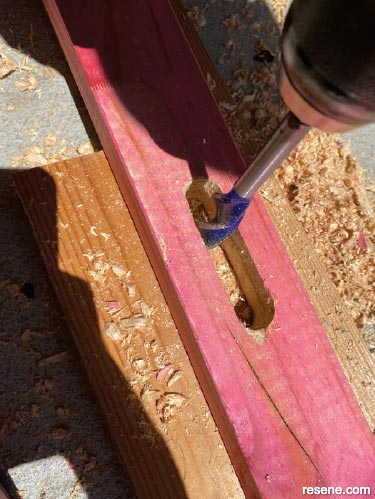 Step one
Step one
Cut out a notch to use as a handle in the middle of one 1200mm length of timber. We used a 20mm drill bit, but a jigsaw would be helpful if you have one. Alternatively, simply screw a handle into position once painted.
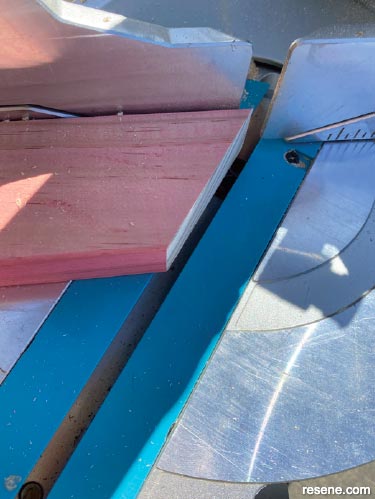 Step two
Step two
Cut an end off each of the four 330mm lengths at 35 degrees for the base of the legs.
 Step three
Step three
On the opposite end to the 35-degree cut, cut each corner off at 30 degrees, creating an arrow shape at the other end of the legs. This will ensure your legs can rotate once attached to the board.
 Step four
Step four
Mark a point 20mm down from the tip and, using a drill bit the same thickness as your bolts, drill a hole in each leg.
 Step five
Step five
Arrange each of the two rectangular frames by placing two 600mm lengths of timber between the 1200mm lengths. Measure and trim the 600mm lengths as needed so that when screwed together, the frame is 1200mm x 600mm to match the size of the two plywood panels.
 Step six
Step six
Screw a plywood panel to each frame. Run a thin line of wood glue on the edge of each framing piece before screwing together.
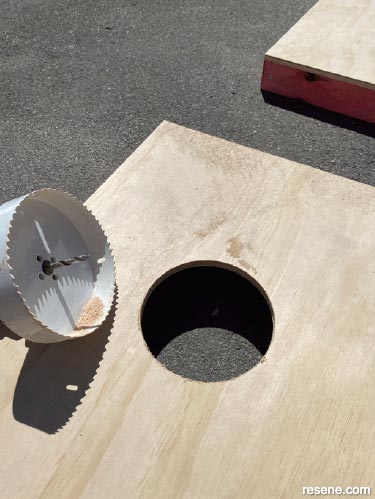 Step seven
Step seven
Mark a point in the centre of each width of plywood panel, 230mm down from the short edge. Using this mark as a guide for the hole’s centre, use a 150mm hole saw to cut out a hole in each board.
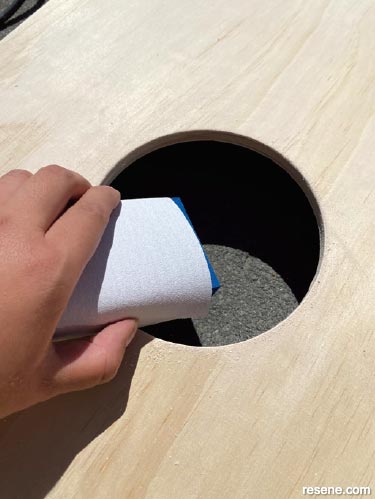 Step eight
Step eight
Sand the edges of each hole until they are smooth.
 Step nine
Step nine
Place the legs in position, leaving a 30mm gap between the top of the leg and the end of the frame. Using the existing hole in the leg pieces as a guide, drill a hole through the frame. Slide the bolt through both holes and secure with a washer and nut. Check that the legs can fold up and down freely. Flip the board upright, fold the legs out and measure to ensure that the top corner is 300mm off the ground. Repeat with the second board.
 Step ten
Step ten
Now comes the fun part – customise your boards! Use painter’s tape to tape off any straight lines and apply two coats of Resene Lustacryl.
 Step eleven
Step eleven
Screw the lift-off hinges into position on the frames, on the opposite edge to the handle.
 Step twelve
Step twelve
Fold boards together and screw the latch into position, on the opposite side to the hinges.
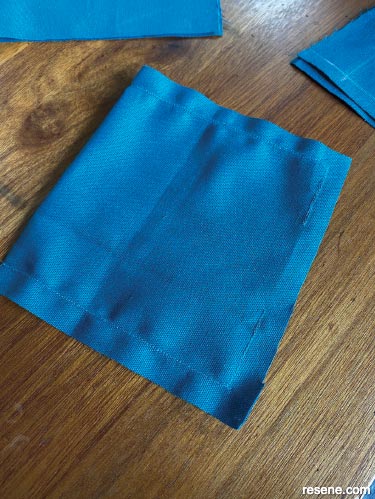 Step thirteen
Step thirteen
Fold one piece of fabric in half (inside out) and draw a line 1cm in from each open edge. With the sewing machine, double stitch along your lines, leaving a gap on the middle side, as shown.
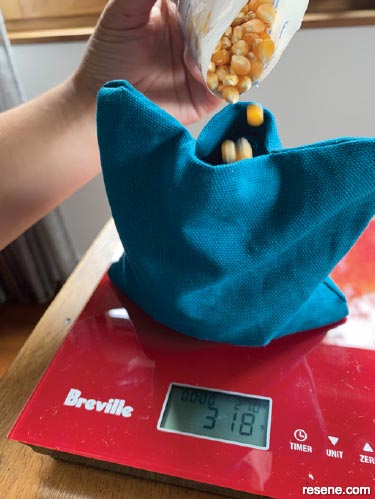 Step fourteen
Step fourteen
Invert the bag, poking out the corners, and fill with 450g of corn (or other filling).
 Step fifteen
Step fifteen
Fold the opening in by the seam and sew the bag closed, sewing a double line for durability. Repeat to create four bags in each colour.
 Step sixteen
Step sixteen
Scoreboard: Make the point markers. Dip each dowel in wood glue and insert into a wooden bead. Once the glue is dry, paint the markers, one in each colour.
 Step seventeen
Step seventeen
Draw two straight lines down one of the timber boards, spaced 100mm from the sides. Mark 22 points along each line, spaced 35mm apart. Using a drill bit slightly bigger than the dowel you are using, drill a hole at each mark. Drill a hole in a offcut first to check you’re happy with the fit.
 Step eighteen
Step eighteen
Paint both lengths of timber board using a similar look as your cornhole boards so that they match. We painted stripes on the front of the scoreboard and painted the rest a solid colour.
 Step nineteen
Step nineteen
Once the paint is dry, add the numbers between each hole (0–21 from the bottom up). You may find it helpful to draw a grid and use a stencil for this step.
 Step twenty
Step twenty
Screw both hinges into position at the top of both boards (to create an A-frame when folded).
 To store
To store
Place the scoreboard and bags inside one board and place the other on top, sliding the hinges together and securing with the latch.